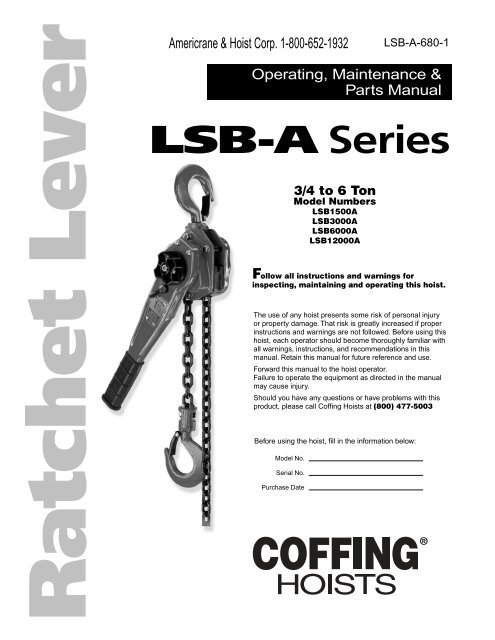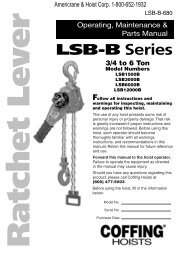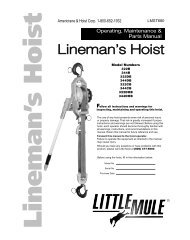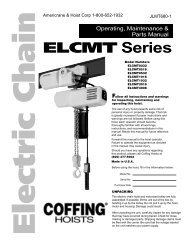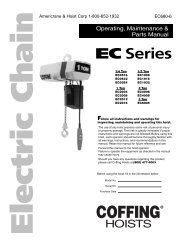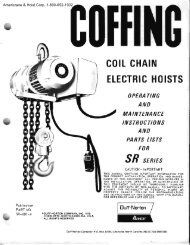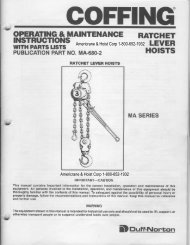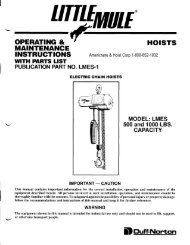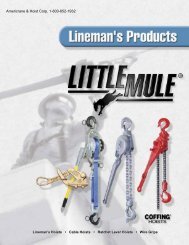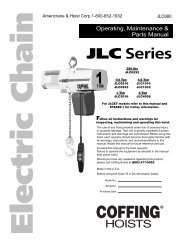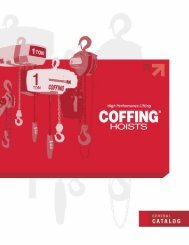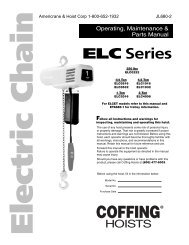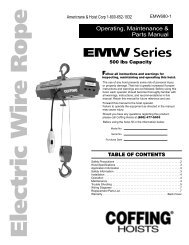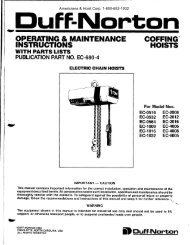LSB-A Series - Coffing Hoists, Coffing Hoist Parts
LSB-A Series - Coffing Hoists, Coffing Hoist Parts
LSB-A Series - Coffing Hoists, Coffing Hoist Parts
You also want an ePaper? Increase the reach of your titles
YUMPU automatically turns print PDFs into web optimized ePapers that Google loves.
Ratchet LeverAmericrane & <strong>Hoist</strong> Corp. 1-800-652-1932<strong>LSB</strong>-A-680-1Operating, Maintenance &<strong>Parts</strong> Manual<strong>LSB</strong>-A <strong>Series</strong>Follow all instructions and warnings forinspecting, maintaining and operating this hoist.The use of any hoist presents some risk of personal injuryor property damage. That risk is greatly increased if properinstructions and warnings are not followed. Before using thishoist, each operator should become thoroughly familiar withall warnings, instructions, and recommendations in thismanual. Retain this manual for future reference and use.Forward this manual to the hoist operator.Failure to operate the equipment as directed in the manualmay cause injury.Should you have any questions or have problems with thisproduct, please call <strong>Coffing</strong> <strong><strong>Hoist</strong>s</strong> at (800) 477-5003Before using the hoist, fill in the information below:Model No.Serial No.Purchase Date3/4 to 6 TonModel Numbers<strong>LSB</strong>1500A<strong>LSB</strong>3000A<strong>LSB</strong>6000A<strong>LSB</strong>12000A
Country Club RoadP.O. Box 779Wadesboro, NC 28170 USATEL: (800) 477-5003FAX: (800) 374-6853Americrane & <strong>Hoist</strong> Corp. 1-800-652-1932SAFETY PRECAUTIONSEach <strong>Coffing</strong> <strong>LSB</strong>-A Manually Lever Operated Chain <strong>Hoist</strong> isbuilt in accordance with the specifications contained hereinand at the time of manufacture complies with ourinterpretation of applicable sections of *American Society ofMechanical Engineers Code (ASME) B30.21 and the*American National Standards Institute ANSI/ASME HST-3M.*Copies of this Standard can be obtained from ASME OrderDepartment, 22 Law Drive, Box 2300, Fairfield, NJ 07007-2300, U.S.A.Improper operation of a hoist can create a potentiallyhazardous situation which, if not avoided, couldresult in death or serious injury. To avoid such apotentially hazardous situation, the operator shall:1. NOT operate a malfunctioning or unusually performing hoist.2. NOT operate the hoist until you have thoroughly read andunderstood the manufacturer’s Operating and MaintenanceInstructions or Manuals.3. NOT operate a hoist which has been modified without themanufacturer’s approval or certification to be in conformitywith applicable OSHA regulations.4. NOT lift or pull more than rated load for the hoist.5. NOT use damaged hoist or hoist that is NOT workingproperly.6. NOT use hoist with twisted, kinked, damaged, or worn loadchain.7. NOT operate with any lever extension (cheater bar).8. NOT attempt to “free-chain” the hoist while a load is applied.9. NOT use the hoist to lift, support, or transport people.10. NOT lift loads over people and make sure all personnelremain clear of the supported load.11. NOT attempt to lengthen the load chain or repair damagedload chain.12. Protect the hoist’s load chain from weld splatter or otherdamaging contaminants.13. NOT operate hoist when it is restricted from forming astraight line from hook to hook in the direction of loading.14. NOT use load chain as a sling or wrap load chain aroundload.15. NOT apply the load to the tip of the hook or the hook latch.16. NOT apply load unless load chain is properly seated in thechain wheel(s) or sprocket(s).17. NOT apply load if bearing prevents equal loading on all loadsupporting chains.18. NOT operate beyond the limits of the load chain travel.19. NOT leave load supported by the hoist unattended unlessspecific precautions have been taken.20. NOT allow the chain or hook to be used as an electrical orwelding ground.21. NOT allow the chain or hook to be touched by a live weldingelectrode.22. NOT remove or obscure the warnings on the hoist.23. NOT operate a hoist which has NOT been securely attachedto a suitable support.24. NOT operate a hoist unless load slings or other approvedsingle attachments are properly sized and seated in the hooksaddle.25. NOT lift loads that are NOT balanced and that the holdingaction is NOT secure, taking up slack carefully.26. NOT operate a hoist unless all persons are and remain clearof the supported load.27. Report malfunctions or unusual performances of a hoist, afterit has been shut down until repaired.28. NOT operate a hoist on which the safety placards or decalsare missing or illegible.29. Be familiar with operating controls, procedures, and warnings.Improper operation of a hoist can create a potentiallyhazardous situation which, if not avoided, couldresult in minor or moderate injury. To avoid such apotentially hazardous situation, the operator shall:1. Maintain a firm footing or be otherwise secured whenoperating the hoist.2. Check brake function by tensioning the hoist prior to each liftor pulling operation.3. Use hook latches. Latches are to retain slings, chains, etc.under slack conditions only.4. Make sure the hook latches are closed and not supportingany parts of the load.5. Make sure the load is free to move and will clear allobstructions.6. Avoid swinging the load or hook.7. Avoid lever “fly-back” by keeping a firm grip on the lever untiloperating stroke is completed and the lever is at rest.8. Inspect the hoist regularly, replace damaged or worn parts,and keep appropriate records of maintenance.9. Use the hoist manufacturer’s recommended parts whenrepairing the unit.10. Lubricate load chain per hoist manufacturer’srecommendations.11. NOT use the hoist load limiting or warning device to measureload.12. NOT operate except with manual power.13. NOT permit more than one operator to pull on lever at thesame time. More than one operator is likely to cause hoistoverload.14. NOT allow your attention to be diverted from operating thehoist.15. NOT allow the hoist to be subjected to sharp contact withother hoists, structures, or objects through misuse.16. NOT adjust or repair the hoist unless qualified to performsuch adjustments or repairs.1
Americrane & <strong>Hoist</strong> Corp. 1-800-652-1932Country Club RoadP.O. Box 779Wadesboro, NC 28170 USATEL: (800) 477-5003FAX: (800) 374-6853TABLE OF CONTENTSSafety Precautions......................................................................................................................................................................1<strong>Hoist</strong> Specifications.....................................................................................................................................................................2Application Information ...............................................................................................................................................................2Safety Information .......................................................................................................................................................................3Operation ....................................................................................................................................................................................4Maintenance ...............................................................................................................................................................................4Replacement <strong>Parts</strong> List...............................................................................................................................................................9<strong>Parts</strong> Depot & Warranty Repair Centers...................................................................................................................................17Warranty .....................................................................................................................................................................Back CoverHOIST SPECIFICATIONS<strong>Coffing</strong> Lever <strong><strong>Hoist</strong>s</strong> are made of the best selected materials,to produce top of the line material handling equipment. <strong>Coffing</strong>Lever <strong><strong>Hoist</strong>s</strong> are manufactured and processed through up todate streamlined production facilities by skilled engineersunder strict quality control. All lever hoists are tested beforeleaving our factory.APPLICATION INFORMATION1. Inspect carefully for any damage that may occur duringshipping. Check for loose, missing, or damaged parts.2. Lubricate the load chain along with whole length withmachine oil (See Figure 2).LubricationGuide HandleSelector LeverOperating HandleFigure 2 - Chain Lubrication3. Examine the load chain to ensure that there is no twist. Whenyour lever hoist is a 6 ton that lifts on 2 falls of load chains,twists can arise from the bottom hook being accidentallyturned over through the load chains (See Figure 3).4. Confirm that the supporting structure is strong enough tosupport the full rated capacity of the lever hoist with agenerous factor of safety.Figure 1 - Lever <strong>Hoist</strong>Table 1 - <strong>Hoist</strong> SpecificationsRated Std. Chain Minimum Pull on Length of Net TestCapacity Lift dia. Distance lever to operating Weight Load(tons) (ft) x falls Between lift full handle (lbs) (tons)Hooks (in) load (lbs) (in).75 5 ø5.6mmx1 11 5 /8 46 9 1 /4 13 1.1251.5 5 ø7.1mmx1 14 31 /32 55 13 3 /4 21 2.253 5 ø9mmx1 16 9 /16 77 13 3 /4 33 4.56 5 ø9mmx2 22 7 /16 84 13 3 /4 63 9.0Figure 3 - Correcting Chain TwistThe design, materials and specifications are subject tochange for improvements without notice.2
Country Club RoadP.O. Box 779Wadesboro, NC 28170 USATEL: (800) 477-5003FAX: (800) 374-6853Americrane & <strong>Hoist</strong> Corp. 1-800-652-1932SAFETY INFORMATION1. Keep the load within the rated capacity marked on the leverhoist. An excess load may lead to an accident. The leverhoist is overloaded when the pulling effort indicated in thestandard specifications is exceeded (See Table 1).2. Before operating, lift and lower the load about 4" and testthe brake system. Ineffective braking may lead to anaccident.3. Loads must be lifted as slowly as possible. Load swingingand abrupt shocks will impose on the lever hoist excessiveburdens double or more the weight of the load.4. Extreme temperatures will affect the durability of the leverhoist. In subzero temperatures loads must be lifted andlowered very slowly and carefully.8. Lifting a load with two lever hoists is not recommended. If thejob is unavoidable, keep the load well within the total ratedcapacity of the two lever hoists; lift with exceptional carewhile maintaining proper balance, angle and lifting speed.In applications similar to Figures 6 through 9, be sureto use the correct slings and attachments to ensuresafe operation and long life of the lever hoist.Figure 6Figure 4 - Incorrect Attachment5. When hooking, the load must be applied squarely to thecenter of the hook and the hook must not come looseduring operation. NEVER USE THE HOOK DIRECTLY ONA LOAD (See Figure 4). Use the attachments as shown inFigure 5.Figure 7Figure 8Figure 5 - Correct AttachmentFigures 6 through 9 show improper hooking methods, whichmay cause the hook to elongate or bend. These hookingmethods may also obstruct the load chain flow to the loadsheave and prevent the lever hoist from operating properly.6. Never run the chain out too far. When the lever hoist is runout beyond the range of lift, a dangerous excessive loadwill be imposed on the load chain, stop grip and gearing.7. The selector lever must be set to the “UP” position whenthe lever hoist is under a load during hoisting or pulling.Figure 93
Americrane & <strong>Hoist</strong> Corp. 1-800-652-1932Country Club RoadP.O. Box 779Wadesboro, NC 28170 USATEL: (800) 477-5003FAX: (800) 374-68539. Do not throw or drop the lever hoist from high places; donot drag the lever hoist in transportation. Doing so maycause damage that may lead to an accident.10. Never leave or store the lever hoist with the brake systemlocked. Loosen the brake system by operating the leverhoist as if lowering a load.11. Always service and repair the lever hoist after use.Thoroughly clean the dust or if used in the rain, wipe off thedirt and moisture and lubricate the lever hoist to prevent rust.12. Inspect the hooks and load chain for bends and any othertypes of defects. Also check to see if the hooks rotate. Ifany defect is found, replace the defective componentbefore using the lever hoist again.RESETTINGThe lever hoist will automatically change from the free-chainingcondition to the brake locked condition when a load is applied.Apply the load with one of the following two methods:a. Turn the guide handle clockwise till the brake locks from theforce of the load.b. Pull firmly on the stop grip until the brake locks from theforce of the load (See Photo 1).Next, turn the selector lever to the “UP” position and hoist orpull by manipulating the operating handle.OPERATIONHOISTING (PULLING) AND LOWERING(RELEASING)Do not forget to lubricate the load chain, rotationsection of the bottom hook and the chain guides.1. <strong>Hoist</strong>ing (Pulling)Set the selector lever to the “UP” position. Take up theslacked load chain by turning the guide handle clockwise.Nest, manipulate the operating handle clockwise.2. Lowering (Releasing)Set the selector lever to the “DOWN” position. Manipulatethe operating handle counterclockwise. When there is noload on the lever hoist, the load chain can be slacked byturning the guide handle counterclockwise.FREE-WHEELINGThis operation is for making quick large adjustments of theload chain length.Set the selector lever to the “N” position and pull the load chainout in the desired direction.Free-chaining will not be possible during the followingconditions:1. When the lever hoist is under a load.2. When the guide handle is in contact with something and notrotating freely.3. When the brake has locked from a large or abrupt load:Turn the guide handle 45° counterclockwise to unlockthe brake.4. When the brake is locked:The brake can be unlocked by setting the selector lever tothe “DOWN” position and manipulating the operating handlecounterclockwise.Photo 1 - Slack Chain Take-UpMAINTENANCEThe lever hoist is designed and made to withstand heavy-dutymaterials handling operations, but wear and damage areunavoidable after a long period of use and depending on theplace and method of use. This is why we suggest that yourcompany or workshop adapt a periodical inspection programfor the lever hoist.1. Never leave the lever hoist in a damp environment or dampweather such as rain. Always store the lever hoist in a dryairy area.2. Proper lubrication will help lengthen the life of the lever hoist.Before storing check to see if the lever hoist is welllubricated. Be especially sure that the moving parts such asgears and bearings are well lubricated.LOAD CHAINLoad chains worn-out or elongated beyond the permissibledimensions must be replaced at once. Replace the entire loadchain immediately if even one link of the load chain isextensively worn-out, elongated or damaged.HOOKSIf the hook opening is elongated beyond the permissibledimension, the hook is dangerously deformed and must bereplaced at once. No deformation of the hook will arise whenthe lever hoist is used and maintained properly.4
Country Club RoadP.O. Box 779Wadesboro, NC 28170 USATEL: (800) 477-5003FAX: (800) 374-6853Americrane & <strong>Hoist</strong> Corp. 1-800-652-1932Figure 10 - Chain InspectionFigure 11 - Hook InspectionCapacity Diameter Standard Limit(tons) (ømm) (in.) (in.).75 5.6 6.732 6.8661.5 7.1 8.346 8.5113 & 6 9 10.748 10.964“C” DimensionCapacity Standard Size Limit(tons) (in.) (in.).75 1 3 /16 1 5 /161.5 1 17 /32 1 11 /163 1 21 /32 1 13 /166 2 3 /64 2 1 /4NOTE: Limit *C (in.) are the maximum permissibledimensions of the hooks, which are about 10% wider thanthe standard hook openings.Slip caused by ineffective braking.TROUBLE SHOOTING––– Probable Cause ––– ––– Remedy–––1. Worn-out friction discs.2. Excessive oil on the braking surface.3. Incorrect assembly of the brake system.1. Replace with new friction discs.2. Disassemble and clean.3. Assemble correctly.Load dropped while lowering.1. Damaged friction discs.2. Foreign matters in the braking system.1. Replace with new ones.2. Disassemble and clean.Jammed operating handle.Over-tightening of the brake.Operate the lever hoist as if lowering a load.Noises during hoisting and lowering operation.Wear or deformation of the load chain and load sheave.Replace with new parts.Operating handle becomes difficult to operate during lifting or lowering operation.1. Over-hoisting or over-lowering.2. Twist in the load chain causing it to get caught between load sheaveand load chain guide.1. Operate the hoist in opposite direction.2. Operate the hoist in opposite direction and remove the twist from the load chain.5
Country Club RoadP.O. Box 779Wadesboro, NC 28170 USATEL: (800) 477-5003FAX: (800) 374-6853Americrane & <strong>Hoist</strong> Corp. 1-800-652-1932NOTES6
Country Club RoadP.O. Box 779Wadesboro, NC 28170 USATEL: (800) 477-5003FAX: (800) 374-6853Americrane & <strong>Hoist</strong> Corp. 1-800-652-1932INSPECTION AND MAINTENANCE CHECK LISTLEVER OPERATED CHAIN HOISTType of <strong>Hoist</strong> ___________________________________________________________Location _______________________________________________________________Manufacturer___________________________________________________________Capacity (Tons) _________________________________________________Original Installation Date _______________________________________Manufacturer’s Serial No. _______________________________________Item Frequency of Inspection Possible Deficiencies OK ActionRequiredFrequent PeriodicDaily Monthly 1-12 Mo.Load Chain * * * Inadequate lubrication, excessive wear or stretch, cracked,damaged or twisted links, corrosion or foreign substanceHooks * * * Excessive throat opening, bent or twisted more than 10°,damaged hook latch, wear, chemical damage, cracksHook Retainers * * * Worn or damaged nuts, pins, washers, collars used to securehook in load block or housingRatchet * Wear, cracks, broken teethHandle Pawl & Load Pawl * Wear, cracks or bindingPawl Springs * Breaks, corrosion, loss of tensionRetaining Rings * Missing or loss of retentionPawl Stud * Excessive wear, pawl retention, loosenessSheave, Pinion Shaft, * Distortion, cracks, excessive wear, damaged threads, buildChain Attachmentsup of foreign substancesGearing * Inadequate lubrication, distortion, cracks, worn or broken teethBearings, Shafts * Inadequate lubrication, distortion, cracks, excessive wearHousing, Load Block, * Cracks, distortion, loose bolts, nuts or rivets. Internal build upOutrigger, Hook Swivelsof foreign substancesNuts, Bolts, Rivets * Looseness, stripped or damaged threadsSupporting Structure * Damage or wear which restricts ability to supportimposed loadsCapacity Plate & Decals * Missing, damaged or illegibleNOTE: Refer to Maintenance and Inspection Sections of the <strong>Hoist</strong>-Maintenance Manual for further details.FREQUENCY OF INSPECTIONFrequent — Indicates items requiring inspection daily to monthly. Daily inspections may be performed by the operator if properly designated.Periodic — Indicates items requiring inspection monthly to yearly. Inspections to be performed by or under the direction of a pr operly designated person. The exactperiod of inspection will depend on frequency and type of usage. Determination of this period will be based on the user’s experi ence. It is recommendedthat the user begin with a monthly inspection and extend the periods to quarterly, semi-annually or annually based on user’s mo nthly experience.Figure 12A — Recommended Inspection and Maintenance Check ListNOTE: This inspection and maintenance check list is in accordance with our interpretation of the requirements of the SafetyStandard for Overhead <strong><strong>Hoist</strong>s</strong> ASME B30.16. It is, however, the ultimate responsibility of the employer/user to interpret andadhere to the applicable requirements of this safety standard.7
Americrane & <strong>Hoist</strong> Corp. 1-800-652-1932Country Club RoadP.O. Box 779Wadesboro, NC 28170 USATEL: (800) 477-5003FAX: (800) 374-6853ITEMINSPECTOR’S REPORTREMARKS (LIST DEFICIENCIES AND RECOMMENDED ACTION)Inspector’sDateSignature Inspected Approved by DateFigure 12B — Recommended Inspector’s ReportRECOMMENDED LUBRICATION SCHEDULE*COFFING LEVER OPERATED CHAIN HOISTFIGURE COMPONENT TYPE OF LUBRICANT TYPE OF SERVICE ANDNUMBERSFREQUENCY OF LUBRICATIONSee Figures 12-15HEAVY NORMAL INFREQUENTLoad Chain SAE 20-30 gear oil Daily Weekly MonthlySee Figures 12-15 Load Pawl Shaft, Multi-purpose Lithium base At periodic inspection (see Figure 10A)Pinion Shaft, Gear & bearing greaseBearings, Pinion &Gear TeethSee Figures 12-15 Bottom Block Shaft, SAE 20-30 gear oilBearing & Hook SwivelMonthly Yearly Yearly(*) This lubrication schedule is based on a hoist operating in normal environment conditions. <strong><strong>Hoist</strong>s</strong> operating in adverseatmospheres containing excessive heat, corrosive fumes or vapors, abrasive dust, etc., should be lubricated more frequently.CAUTION - DO NOT LUBRICATE BRAKE AREA OF HOIST.Figure 13 — Recommended Lubrication Schedule8
Contact your nearest <strong>Coffing</strong> <strong><strong>Hoist</strong>s</strong> Service Center forparts and service. For a complete list, see pages 17 and 18.Please have the hoist model number, serial number, andpart number with description available for reference.Americrane & <strong>Hoist</strong> Corp. 1-800-652-1932Figure 14 - 0.75 Ton Model202231312532151114131242029721318910511282972816301733223740321838362624639271934 359
Americrane & <strong>Hoist</strong> Corp. 1-800-652-1932Contact your nearest <strong>Coffing</strong> <strong><strong>Hoist</strong>s</strong> Service Center forparts and service. For a complete list, see pages 17 and 18.Please have the hoist model number, serial number, andpart number with description available for reference.<strong>Parts</strong> List for 0.75 Ton ModelRef.PartNo. Description No. Qty1 Pinion Shaft IRB4001 12 Pinion with Pinion Gear IRB4002T 23 Load Gear IRB4004 14 Load Sheave IRB4005 15 Load Chain T56 16 Stop Grip IRB40062 17 Pawl IRB4007 28 Disc Hub IRB4008 19 Ratchet Wheel IRB4009 1 set10 Interlocking Ring IRB4011 111 Chain Guide IRB4012A 212 Stripper IRB4015A 113 Gear Side Plate IRB4018A 114 Handle Side Plate IRB4020A 115 Stay Bolt (D) IRB4021 116 Disc Nut IRB4023 117 Operating Handle IRB4024 118 Spring Shaft IRB4030 119 Shaft Base IRB4031 120 Gear Cover IRB4037 121 Ratchet Cover IRB4040T 122 Guide Handle IRB4042 123 Top Hook Assembly IRB4048U 124 Bottom Hook Assembly IRB4053U 125 Pinion Shaft Washer IRB4059 126 Safety Latch Assembly JHH5074T 227 Change-over Spring IRB4101 128 Snap Ring SRC51010 229 Pawl Spring IRB4104 230 Free-Wheeling Spring IRB4106 131 Spring Nut HSNM8 832 Spring Nut HSNM6 233 Screw & Spring Washer CMSM6 x 10S2 134 Flat Washer IRB4136 135 Lock Nut HNNM8 136 Chain Fastening Bolt IRB4124 137 Lock Nut HUN1M6 138 Screw & Spring Washer CMSM6 x 25S2 239 Socket Bolt CBM6 x 35 140 Lock Nut HNNM6 110
Contact your nearest <strong>Coffing</strong> <strong><strong>Hoist</strong>s</strong> Service Center forparts and service. For a complete list, see pages 17 and 18.Please have the hoist model number, serial number, andpart number with description available for reference.Americrane & <strong>Hoist</strong> Corp. 1-800-652-1932Figure 15 - 1.5 Ton Model2122413126314216131522321731842189341012541138413072930729331923393727256402820353611
Americrane & <strong>Hoist</strong> Corp. 1-800-652-1932Contact your nearest <strong>Coffing</strong> <strong><strong>Hoist</strong>s</strong> Service Center forparts and service. For a complete list, see pages 17 and 18.Please have the hoist model number, serial number, andpart number with description available for reference.<strong>Parts</strong> List for 1.5 Ton ModelRef.PartNo. Description No. Qty1 Pinion Shaft KRB4001 12 Pinion with Pinion Gear KRB4002T 23 Load Gear KRB4004 14 Load Sheave KRB4005 15 Load Chain V71 16 Stop Grip KRB40062 17 Pawl IRB4007 28 Disc Hub KRB4008 19 Ratchet Wheel KRB4009 1 set10 Interlocking Ring KRB4011 111 Chain Guide KRB4012A 112 Stripper KRB4015A 113 Chain Guide KRB4017 114 Gear Side Plate KRB4018A 115 Handle Side Plate KRB4020A 116 Stay Bolt (D) KRB4021 117 Disc Nut KRB4023 118 Operating Handle NRB4024 119 Spring Shaft IRB3030 120 Shaft Base IRB3031 121 Gear Cover KRB4037 122 Ratchet Cover KRB4040T 123 Guide Handle IRB4042 124 Top Hook Assembly KRB4048U 125 Bottom Hook Assembly KRB4053U 126 Pinion Shaft Washer IRB4059 127 Safety Latch Assembly KHH5074T 228 Change Over Spring IRB3116 129 Snap Ring SRC51010 230 Pawl Spring KRB4104 231 Free Wheeling Spring KRB4106 132 Spring Nut HSNM8 833 Spring Nut HSNM8 234 Screw & Spring Washer CMSM6 x 10S2 235 Flat Washer IRB4136 136 Lock Nut HNNM8 137 Chain Fastening Bolt KHH5048 138 Lock Nut HUN1M8 139 Screw & Spring Washer CMSM6 x 25S2 240 Socket Bolt CBM8 x 50 141 Lock Nut HNNM8 142 Snap Ring SRC51014 112
Contact your nearest <strong>Coffing</strong> <strong><strong>Hoist</strong>s</strong> Service Center forparts and service. For a complete list, see pages 17 and 18.Please have the hoist model number, serial number, andpart number with description available for reference.Americrane & <strong>Hoist</strong> Corp. 1-800-652-1932Figure 16 - 3 Ton Model2022312426314321321241530 72911538307 2921328423727254064133161828319101734223935361913
Americrane & <strong>Hoist</strong> Corp. 1-800-652-1932Contact your nearest <strong>Coffing</strong> <strong><strong>Hoist</strong>s</strong> Service Center forparts and service. For a complete list, see pages 17 and 18.Please have the hoist model number, serial number, andpart number with description available for reference.<strong>Parts</strong> List for 3 Ton ModelRef.PartNo. Description No. Qty1 Pinion Shaft NRB4001 12 Pinion with Pinion Gear NRB4002T 23 Load Gear NRB4004 14 Load Sheave NRB4005 15 Load Chain V9 16 Stop Grip NRB40062 17 Pawl NRB4007 28 Disc Hub KRB4008 19 Ratchet Wheel KRB4009 1 set10 Interlocking Ring KRB4011 111 Chain Guide NRB4012 112 Stripper NRB4015 113 Chain Guide NRB4017 114 Gear Side Plate NRB4018 115 Handle Side Plate NRB4020 116 Disc Nut KRB4023 117 Operating Handle NRB4024 118 Spring Shaft IRB3030 119 Shaft Base IRB3031 120 Gear Cover NRB4037 121 Ratchet Cover NRB4040T 122 Guide Handle IRB4042 123 Top Hook Assembly NRB4048U 124 Yoke Pin NRB4051 125 Bottom Hook Assembly NRB4053U 126 Pinion Shaft Washer NRB4059 127 Safety Latch Assembly KHH5074T 228 Change Over Spring IRB3116 129 Snap Ring SRC51012 230 Pawl Spring KHH5010 231 Free Wheeling Spring NRB4106 132 Spring Nut HSNM10 833 Spring Nut HSNM8 234 Screw & Spring Washer CMSM6 x 10S2 235 Flat Washer IRB4136 136 Lock Nut HNNM8 137 Chain Fastening Bolt NRB4124 138 Lock Nut HUN1M10 139 Screw & Spring Washer CMSM6 x 25S2 240 Socket Bolt LHH5048 141 Lock Nut HNNM8 142 Snap Ring SRC51014 114
Contact your nearest <strong>Coffing</strong> <strong><strong>Hoist</strong>s</strong> Service Center forparts and service. For a complete list, see pages 17 and 18.Please have the hoist model number, serial number, andpart number with description available for reference.Americrane & <strong>Hoist</strong> Corp. 1-800-652-1932Figure 17 - 6 Ton Model2021242332230314421213414 153473311733213684891054544282926342927314746 61635173825284445371832224339401915
Americrane & <strong>Hoist</strong> Corp. 1-800-652-1932Contact your nearest <strong>Coffing</strong> <strong><strong>Hoist</strong>s</strong> Service Center forparts and service. For a complete list, see pages 17 and 18.Please have the hoist model number, serial number, andpart number with description available for reference.<strong>Parts</strong> List for 6 Ton ModelRef.PartNo. Description No. Qty1 Pinion Shaft NRB4001 12 Pinion with Pinion Gear NRB4002T 23 Load Gear NRB4004 14 Load Sheave NRB4005 15 Load Chain V9 16 Stop Grip NRB40062 17 Pawl NRB4007 28 Disc Hub KRB4008 19 Ratchet Wheel KRB4009 1 set10 Interlocking Ring KRB4011 111 Chain Guide NRB4012 112 Stripper NRB4015 113 Chain Guide NRB4017 114 Gear Side Plate NRB4018 115 Handle Side Plate NRB4020 116 Disc Nut KRB4023 117 Operating Handle NRB4024 118 Spring Shaft IRB3030 119 Shaft Base IRB3031 120 Gear Cover NRB4037 121 Ratchet Cover NRB4040T 122 Guide Handle IRB4042 123 Top Hook Assembly QRB4048U 124 Yoke Pin NRB4051 125 Bottom Hook Assembly QRB4053U 126 Chain Wheel QRB4055 127 Wheel Pin QRB3056 128 Key Plate QRB3079 229 Wheel Washer HH4100083 230 Pinion Shaft Washer NRB4059 131 Safety Latch Assembly HH4060074T 232 Change Over Spring IRB3116 133 Snap Ring SRC51012 234 Pawl Spring KHH5010 235 Free Wheeling Spring NRB4106 136 Spring Nut HSNM10 837 Spring Nut HSNM8 238 Screw & Spring Washer CMSM6 x 10S2 239 Flat Washer IRB4136 140 Lock Nut HNNM8 141 Chain Fastening Bolt QRB4124 142 Lock Nut HNNM10 143 Screw & Spring Washer CMSM6 x 25S2 244 Spring Washer for 141 SWM8 445 Hexagon Bolt HBM8 x 16B 446 Socket Bolt LHH5048 147 Lock Nut HNNM8 148 Snap Ring SRC51014 116
Americrane & <strong>Hoist</strong> Corp. 1-800-652-1932High Performance Lifting WARRANTYEvery hoist is thoroughly inspected andperformance tested prior to shipment from thefactory. If any properly installed, maintainedand operated hoist as outlined in theapplicable accompanying <strong>Coffing</strong> <strong><strong>Hoist</strong>s</strong>manual develops a performance problem dueto defective materials or workmanship asverified by <strong>Coffing</strong> <strong><strong>Hoist</strong>s</strong>, repair orreplacement of the hoist will be made to theoriginal purchaser without charge and thehoist will be returned, transportation prepaid.This warranty does not apply wheredeterioration is caused by normal wear,abuse, improper or inadequate power supply,improper or inadequate maintenance,eccentric or side loading, overloading,chemical or abrasive actions, excessive heat,unauthorized modifications or repairs, or useof non-<strong>Coffing</strong> repair parts. EXCEPT ASSTATED HEREIN, COFFING HOISTSMAKES NO OTHER WARRANTIES,EXPRESS OR IMPLIED, INCLUDINGWARRANTIES OF MERCHANTABILITY ANDFITNESS FOR A PARTICULAR PURPOSE.Overloading and Improper Use Can Result In InjuryTO AVOID INJURY:• Do not exceed working load limit, load rating, or capacity.• Do not use equipment to lift people or loads over people.• Use only alloy chain and attachments for overhead lifting.• Read and follow all instructions.<strong>Coffing</strong> <strong><strong>Hoist</strong>s</strong> • Country Club Road • P.O. Box 779 • Wadesboro, North Carolina 28170 USATel: 800.477.5003 • Fax: 800.374.6853 • 704.694.6829www.coffinghoists.com<strong>LSB</strong>-A©2003 <strong>Coffing</strong> <strong><strong>Hoist</strong>s</strong>


